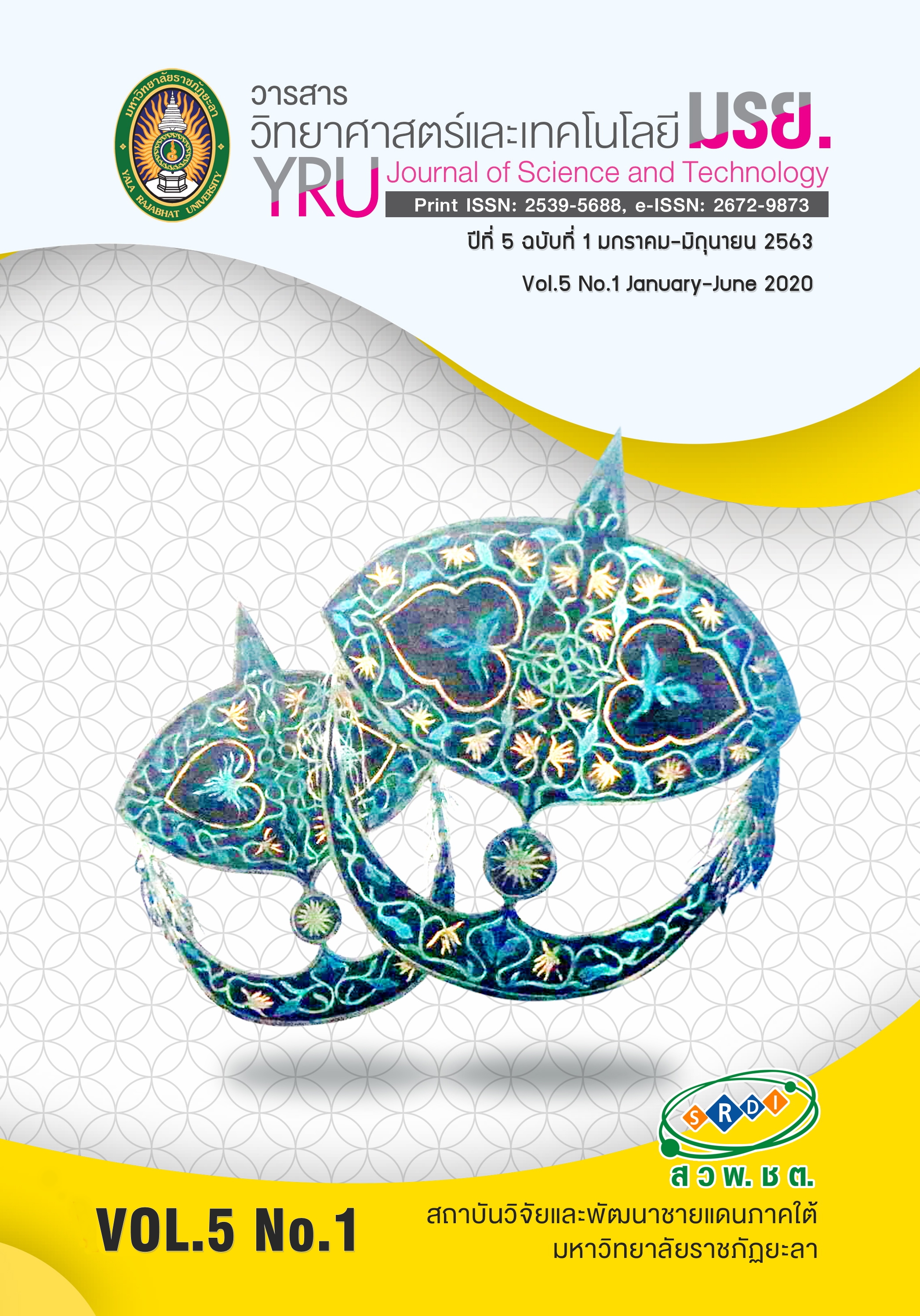การวิเคราะห์องค์ประกอบทางเคมีและสมบัติทางโครงสร้างของกากกาแฟพันธุ์อาราบิก้า
Main Article Content
บทคัดย่อ
การวิเคราะห์ทางเคมีของกากกาแฟในงานวิจัยนี้ จะมุ่งเน้นไปที่การวิเคราะห์องค์ประกอบทางเคมีและสมบัติทางโครงสร้าง ซึ่งองค์ประกอบทางเคมีของกากกาแฟ พบว่ามีปริมาณความชื้นเท่ากับ 2.84±0.17% ปริมาณเถ้าเท่ากับ 14.93±0.55% ปริมาณโปรตีนเท่ากับ 10.93±0.03% ปริมาณไขมันเท่ากับ 14.42±0.43% และปริมาณคาร์โบไฮเดรตเท่ากับ 56.88% ลักษณะสัณฐานวิทยาของกากกาแฟก่อนและหลังสกัดไขมันเมื่อนำไปวิเคราะห์ด้วยกล้องจุลทรรศน์อิเล็กตรอนแบบส่องกราด (SEM) พบว่ารูปที่ได้จากกากกาแฟก่อนสกัดน้ำมันอนุภาคจะรวมตัวกันเป็นกลุ่มก้อน เมื่อผ่านการสกัดน้ำมันจะเห็นว่าอนุภาคจะกระจายตัวแยกออกจากกัน สาเหตุเนื่องมาจากการที่หยดน้ำมันภายในอนุภาคได้ถูกสกัดออกมาจากรูพรุนของกากกาแฟ บนพื้นผิวของกากกาแฟพบปริมาณคาร์บอนและออกซิเจนโดยได้จากการวิเคราห์ผ่านอุปกรณ์ตรวจจับสัญญาณเอกซ์เรย์ (EDS) หมู่ฟังก์ชันหลักของกากกาแฟจะถูกนำไปวิเคราะห์ด้วยเครื่องฟลูเรียร์ทรานส์ฟอร์ม อินฟราเรดสเปคโทรโฟโตมิเตอร์ (FT-IR) ซึ่งผลจากการทดลองนี้สามารถนำไปเป็นข้อมูลเบื้องต้นในระดับอุตสาหกรรมต่อไป
Article Details
บทความ ข้อมูล เนื้อหา รูปภาพ ฯลฯ ที่ได้รับการเผยแพร่ในวารสารวิทยาศาสตร์และเทคโนโลยี มรย. นี้ ถือเป็นลิขสิทธิ์ของวารสารวิทยาศาสตร์และเทคโนโลยี มรย. หากบุคคลหรือหน่วยงานใดต้องการนำทั้งหมดหรือส่วนหนึ่งส่วนใดไปเผยแพร่ต่อหรือกระทำการใดๆ จะต้องได้รับอนุญาตเป็นลายลักษณ์อักษรจากวารสารวิทยาศาสตร์และเทคโนโลยี มรย. ก่อนเท่านั้น
เอกสารอ้างอิง
AOAC. (2000). Official Methods of Analysis (17th ed.), Gaithersburg, MD, USA : The Association of Official
Analytical Chemists.
Ballesteros, L. F., Teixeira, J. A. & Mussatto, S. I. (2014). Chemical, Functional, and Structural Properties of
Spent Coffee Grounds and Coffee Silverskin. Food and Bioprocess Technology, 7(12), 3493–3503.
Brunerova, A., Roubík, H., Brozek, M., Haryanto, A., Hasanudin, U., Iryani, D. A. & Herák, D. (2019).
Valorization of Bio-Briquette Fuel by Using Spent Coffee Ground as an External Additive. Energies, 13(54), 1–15.
Craig, A. P., Franca, A. S. & Oliveira, L. S. (2012). Discrimination between defective and non-defective
roasted coffees by diffuse reflectance infrared Fourier transform spectroscopy. LWT-Food Science
Technology, 47(2), 505–511.
Hamamre, Z. A., Foerster, S., Hartmann, F., Kroger, M. & Kaltschmitt, M. (2012). Oil Extracted from Spent
Coffee Grounds as a Renewable Source for Fatty Acid Methyl Ester Manufacturing. Fuel, 96, 70–76.
Hussein, A., Ali, H., Bareh, G. & Farouk, A. (2019). Influence of Spent Coffee Ground as Fiber Source on
Chemical, Rheological and Sensory Properties of Sponge Cake. Pakistan Journal of Biological Sciences, 22(6), 273–282.
Kovalcik, A., Obruca, S. & Marova, I. (2018). Valorization of Spent Coffee Grounds: A Review. Food and
BioproductsProcessing, 1104(2), 104–119.
Lisowski, A., Olendzki, D. & Swietochowski, A., Dabrowska, M., Mieszkalski, L., Ostrowska-Ligeza, E., Stasiak ,
M., Klonowski, J. & Piatek, M. (2019). Spent Coffee Grounds Compaction Process: Its Effects on
the Strengthproperties of Biofuel Pellets. Renewable Energy, 142, 173–183.
Liu, Y., Tu, Q., Knothe, G. & Lu, M. (2017). Direct Transesterification of Spent Coffee Grounds for Biodiesel
Production. Fuel, 199, 157–161.
Martinez-Saez, N., García, A. T., Pérez, I. D., Rebollo-Hernanz, M., Mesias, M., Morales, F. J., Martín-Cabrejas,
M. A. & Doloresdel Castillo M. (2017). Use of Spent Coffee Grounds as Food Ingredient in Bakery Products. Food Chemistry, 216, 114–122.
Mussatto, S. I., Carneiro, L. M., Silva, J. P.A., Roberto, I. C. & Teixeira J. A. (2011). A Study on Chemical Constituents and Sugars Extraction from Spent Coffee Grounds. Carbohydrate Polymers, 83(2), 368–374.
Rahimnejad, S., Choi, J. & Lee, S. M. (2015). Evaluation of Coffee Ground as a Feedstuff in Practical
Diets for Olive Flounder Paralichthys olivaceus. Fisheries and Aquatic Sciences, 18(3), 257–264.
Rocha, M. V. P, Lima de Matos, L. J. B., Pinto, de Lima L., Marciano da Silva Figueiredo, P., Lucena, I. L.,
Fernandes, F. A. N. & Goncalves, L. R. B. (2014). Ultrasound-assisted Production of Biodiesel and Ethanol from Spent Coffee Grounds. Bioresource Technology, 167, 343–348.
Silva, J. P., Mendez, G. L., Lombana, J., Marrugo, D. G. & Correa-Turizo, R. (2018). Physicochemical
Characterization of Spent Coffee Ground (Coffea Arabica L) and its Antioxidant Evaluation.
Advance Journal of Food Science and Technology, 16, 220–225.
Smaga, M. (2016). Quality Parameters of the Solid Fuel Produced from Coffee Grounds and Tea Grounds. Acta Innovations, 20, 26–30.
Somnuk, K., Eawlex, P. & Prateepchaikul, G. (2017). Optimization of Coffee Oil Extraction from Spent
Coffee Grounds Using Four Solvents and Prototype-scale Extraction Using Circulation Process.
Agriculture and Natural Resources, 51(3), 181–189.
Zarrinbakhsh, N., Wang, T., Rodriguez-Uribe, A., Misra, M., & Mohanty, A. K. (2016). Characterization of
Wastes and Coproducts from the Coffee Industry for Composite Material Production.
BioResources, 11(3), 7637–7653.


